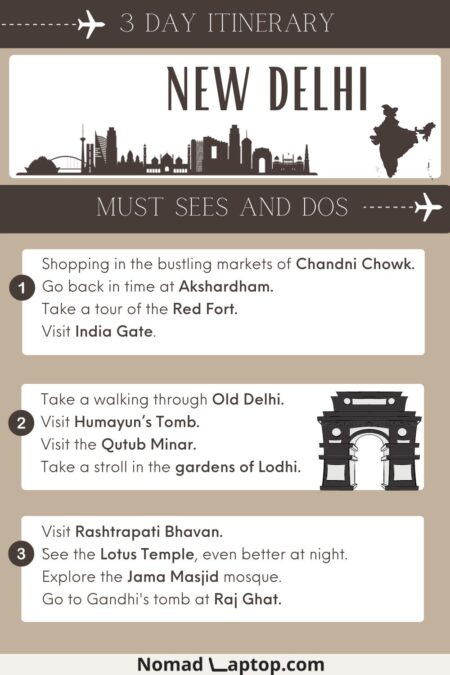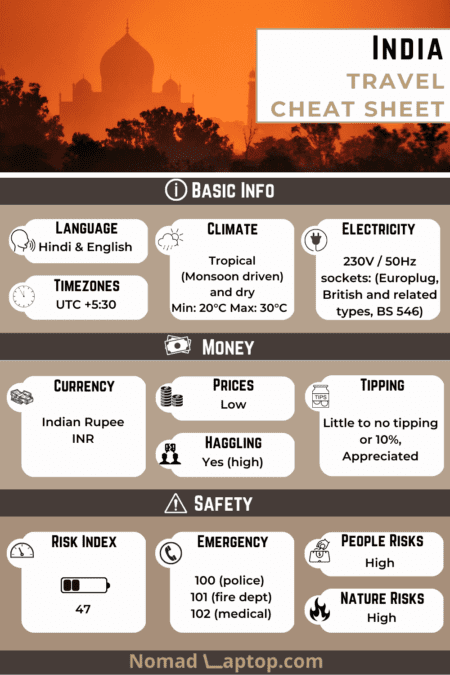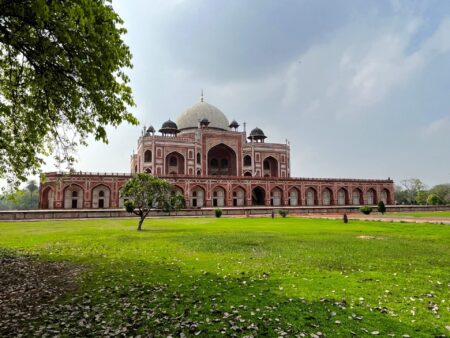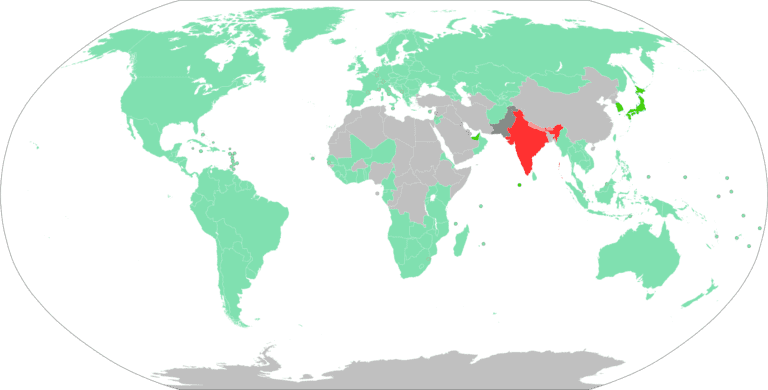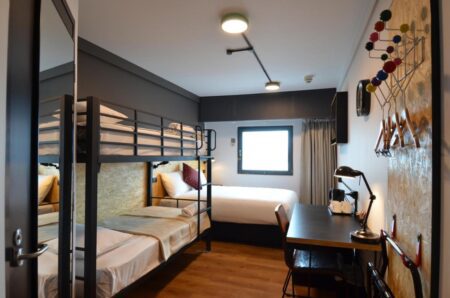New Delhi is the capital of India and one of the most vibrant cities in the world. It is a beautiful city with a rich cultural heritage and amazing architecture.
The city is home to some of the most iconic monuments in India, such as the Red Fort, India Gate, Humayun’s Tomb, and Akshardham. It is also a major cultural, educational, and economic hub in the country.
It is a city filled with energy and life, and it is a great destination for tourists from all over the world. Known also as the city of eight cities, it is a large, sprawling metropolis with tons to offer, and like many other Asia megacities, especially capitals, it is impossible to condense a visit there in just a long weekend. Nevertheless, even a short visit to Delhi will entice its visitors with its diverse population, delicious cuisine, and vibrant nightlife, and the city is sure to give an unforgettable experience.
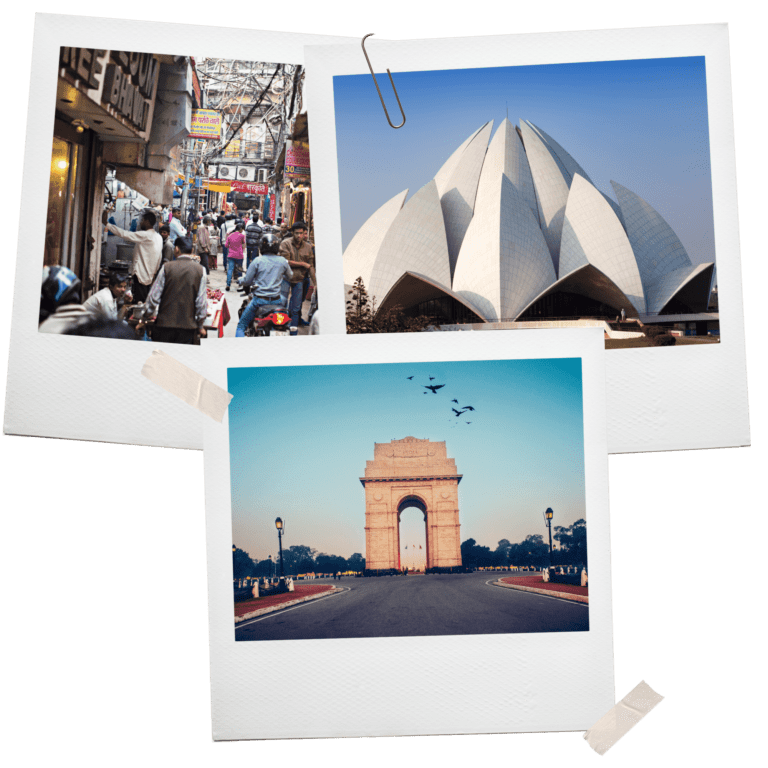
India Info & Stats
- Language: Hindi and English are the official languages.
- Population: 1.4 billion (2020 Est.)
- Timezone: UTC +5:30
- Ethnic Groups: Indo-Aryan 72%, Dravidian 25%, Mongoloid and other 3%
- Religions: 79% Hindu, 14% Muslim, 2% Christian, 2% Sikh
- Political System: Parliamentary Republic
- Currency: Indian Rupee (INR)
- Credit Cards: Credit cards are not widely used. For comparison, the average global use is around 20% and 4% in India. ATMs, though, are evenly spread around the city.
- Electricity: Socket types Europlug, British types, 230 volt / 50 hertz
- Tipping Customs: 10-15% in restaurants and taxis
- Haggling Culture: Common in markets and bazaars
Weather
Winter in Delhi is very cold (at night), with temperatures reaching near freezing. The summers, which are April and May, are very hot, with temperatures that can reach 45 degrees Celsius. The monsoon season from June to September creates high humidity, and autumn may be the best time to visit with warm days and relatively cool nights.
The city is notorious for smog and air pollution and this creates both “protection” from the sun and humid, hard-to-breathe air.
When I visited in late March, I was lucky to have pleasant days, slightly covered and with a night of strong rain but mostly enjoyable (apart from the air quality and general city smells).
Money
The currency is the Indian Rupee (INR).
The real-time exchange rate from US dollars is: 84 INR
Credit cards are seldom accepted and most places will expect you to pay in cash. This goes for taxi drivers and ticket entrances for example. ATMs are not so easy to find (for example, at the airport, there are no ATMs and drivers want to be paid in cash).
Prices: India is not expensive at all. As a visitor, especially someone who is Western and easily identifiable, you will be charged much more for everything. That being said, unless you make it a matter of principle, paying 500 rupees more amounts to 5 USD. Having a driver take you around for the whole day for around 10 dollars is convenient, even if you are paying much more as a foreigner. According to the Mercer Cost of Living City Ranking (updated 2024), Delhi ranks 165th worldwide in terms of most expensive cities to live in (in 2023, it ranked 161st)
Tipping: India doesn’t have a strong tipping culture. In touristic places and tourist-oriented services, it is common to leave a tip of around 10%.
Entry Requirements
There are quite some distinctions in visa requirements based on the visitor’s citizenship.
Click the map to see details on visa requirements for each country
Alternatively, input your passport citizenship and quickly see the requirements that apply to you:
Getting around
The large city doesn’t lend itself to visiting on foot, although I walked a lot (around 10km per day) to see certain parts of Old Delhi, around the Red Fort, and the areas south of Connaught Place.
As in other cities in India, the sheer number of autorickshaws allows for quick and easy travel over short distances between sightseeing spots. Make sure to haggle the price before entering. As everywhere in India, tourists pay something between 5, 10, and even 15 times as much as locals.
The metro is extensive and well-connected. I used this method of transport, and it was easy to get around. A travel card is recommended and there are tourist cards for unlimited trips for 1 or 3 days, but also here, if you can, do not take the tourist card and simply buy the normal local card, which does exactly the same thing.
If you are staying at nice hotels, there are always taxis and private drivers who can take you to the more remote parts of town or just have a more enjoyable air-conditioned trip. Uber and Ola are also viable alternatives
As in many cities, locals use bus transport to move around the city. It may be cheaper and naturally have a more granular distribution, but personally, buses in Asian cities always intimidate me with their packed interiors, relatively bad shape, and unclear fare mechanics.
Safety
Safety: Despite being highly visited by foreigners, the capital is certainly not a city oriented towards tourism. Generally speaking, Delhi is a very dangerous destination, especially for solo female travelers.
Delhi might be the most risky destination for tourists in a country that is already quite dangerous by itself. It is known that even the most experienced travelers may have a hard time in Delhi.
Although there is a risk of mugging, terrorism, and kidnapping, most tourists will have to deal with minor crimes such as pickpocketing and scams which are rampant throughout the city towards tourists.
Health safety is a major concern for foreigners as the waters are notoriously filthy and the risk of debilitating stomach flu (aka Delhi Belly) is very high. I did not experience any, but I was also very cautious since I was traveling on a tight schedule and could not afford to be sick, which would have not only ruined my stay but potentially jeopardized future movements.
Natural risks: India is prone to earthquakes, floods, and severe storms that routinely hit the country, and Delhi is subjected to these as well.
Emergencies number: 112, 100 (police), 101 (fire department), 102 (emergency medical services), 108 (emergency)
Tips & Impressions
- I usually walk a lot in cities and Delhi was no different. However, they say that one day of city smog is equivalent to almost a pack of cigarettes per day. Considering that I smoked that amount regardless, my lungs felt overwhelmed and I had headaches throughout my stay. Moving around via the metro is an excellent means of transport and also takes you away from air pollution. Going underground was like taking a walk in a park with breathable air and this should give an idea of the weather and air quality.
- I should have anticipated it but since I had spent 3 days in Agra in a very nice hotel, I was prepared to rough it up a bit during my stay in Delhi and initially booked a cheaper hotel, close to the railway station. It wasn’t a hostel or dormitory, and it wasn’t that cheap (3000 rupees a night, so something like 30-35 euros). The dirt from the hotel’s large external welcome mat was used as carpet next to my bed, which had several ants. And the shower had no hot water. I moved the next day to a luxury hotel, which was absolutely stunning.
Deals for New Delhi
Where to stay
Luxury
Boutique & Eco-friendly
Budget & Local experience
Travelogue
Accommodation

My accommodation was The IVY Grand which I chose for its proximity to the train station. However, and this was the first time that this happened to me, I left the hotel after 1 night despite having booked for 3. This was due to the general uncleanliness of the place with ants everywhere, the lack of hot water, and unsustainable noise from the streets.
I may have overcompensated the next day and moved to Shangri-La Eros south of Connaught Place which is on a whole different budget range and was extremely pleasant and highly recommendable. The location is central, close to the metro, and the hotel has great restaurants, a wonderful spa, and an outdoor swimming pool.
Day 1
After moving to the new hotel I went for my usual infinite city walk.
Just reaching the Ministry of Defense was quite a long walk. From there the road to India Gate is imposing to say the least. India Gate is in a hexagon where major roads of the city intersect and the pedestrian park avenue which stretches from the Ministry of Defense to the monument is a long 2 km massive open road.
I took one of the nine large roads stretching from India Gate and made my way south towards Safdarjung Tomb. Built in 1754 during the late Mughal Empire, it has typical domed architecture, a large, expansive square garden surrounding it and a wall perimeter, which gives a wonderful sight when it opens up to visitors who pass through the main gateway.
The tomb was being restored but was wonderful with yet another imposing open walkway towards it along the reflection pool dotted with palm trees.
I turned east and made my way to Humayun’s Tomb, stopping at Lodhi Gardens. The gardens are popular for exercise and family picnics and house two large domes in its center which were meant as gateways to the main mosque.
This is the first park I see in India which has impressed me as more than just a garden. In Jaipur, the park behind Patrika Gate was lovely but here the monuments and tombs dotted within the incredibly well-maintained gardens made the stroll through it a wonderful experience.
Humayun’s Tomb is one of the main sightseeing attractions in New Delhi and is similar to the Taj Mahal in the sense that it is hidden behind walls and fortifications to then opens up in its majestic glory once you traverse the main gate.
Built in 1572 to house the remains of the Mughal emperor Humayun and commissioned by his wife and consort, the tomb has a complex interior, with many small chambers radiating from the central hall, each chamber containing smaller tombs of other family members, and intricate carvings on walls and ceilings. This complexity in the interior is in stark contrast with the exterior, which has a simple architecture with a square layout and structure made of red sandstone and white marble. The complex is large and expansive, with the mausoleum overlooking everything in the center.
After having lost feeling in my legs I crawled towards the metro station ending my daily 11kms walkabout the city.
Day 2
During the night a 6.6 intensity earthquake was felt in the city which fortunately didn’t create any major damages or injuries.
The next day I went to the northern part of the city to Old Delhi. Being quite spent from the previous day I didn’t spend a lot of time exploring the winding, bustling streets and only had a quick stroll towards the famous mosque of Jama Masjid.
It is one of the largest mosques in India and a historically significant monument still in use today.
The mosque exterior was being renovated. Also, it was the first day of Ramadan so I did not want to enter the interior and bother any worshippers. It was a very cloudy morning so one of the famous attractions, which is to climb one of the minarets to see the view of the city, would have been pointless. So my visit was quite short and I proceeded to the Red Fort.
I walked to the Red Fort, arguably the most visited attraction in the city. This large, 254 acres, expansive fort of the Mughal Empire was built in 1648 by the same architect who built the Taj Mahal.
Because of an infamous terrorist attack in 2000, the fort is presided over by military and security forces. Walking within the roads inside the fort and seeing the camouflaged outposts on the high walls and turrets with sharpshooters really heightened the feeling of the fort and its defensive capabilities.
There are several monuments inside the fort, some in very good condition while others very less so.
I insisted on my absurd need to walk around instead of using rickshaws and proceeded south of the Red Fort towards Raj Ghat, the tomb of Mahatma Gandhi.
The site is aesthetically wonderful in itself and the slow walk towards the tomb is dotted with epitaphs of famous quotes by the non-violent warrior who liberated India. I was always a big “fan,” but even removing any historical aspects, I highly recommend visiting the site. Removing shoes and slowly proceeding to the tomb, surrounded by nature and soft music playing from outdoor speakers, created a calm and wonderful atmosphere.

